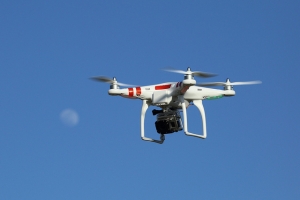

Photo by Don McCullough is licensed under CC BY 2.0
Most people think of drones as unmanned aircraft being used overseas in militarized zones. However, drones will likely impact businesses more than military operations in the very near future. The Federal Aviation Administration (FAA) estimates that the commercial drone industry will likely grow to $90 billion in the coming decade.
According to the Association for Unmanned Vehicle Systems International, it is estimated that the agriculture sector will make up 80 percent of the drone market in the near-term. Not only will drones be able to spray crops, the incredibly precise detailed aerial imaging that drones are capable of producing will enable a strategically directed use of fertilizers and pesticides on crops. This will substantially reduce pollutants in the environment.
Drones can handle oil and gas pipeline inspections, check power lines and assist with surveying and mapping. Predictions are that the oil and gas industry will be the second-largest user of drone technology in the future.
In 2014, Facebook bought aerospace company Ascenta and Google acquired Titan Aerospace, and some believe it is because the tech giants hope to use drone technology to provide wireless Internet to remote parts of the world. Solar drones can stay airborne for many years.
Drones can also provide lifesaving assistance to first responders in almost any emergency situation. The unmanned aircraft can locate lost children, downed aircraft and fugitives trying to escape the law. Drones can be used to drop emergency supplies in hard-to-reach locations and the unmanned devices can be flown over toxic nuclear sites and dangerous environments when detailed assessments are critical.
Some correctional facilities use drones for monitoring perimeters and other governmental agencies want to track and document wildlife with drone technology. Wildfires can be tracked by drones and land damage can be accessed quickly and efficiently.
Construction firms can use drones for aerial pictures to document project work or settle disputes with subcontractors. Warehousing firms hope to use drone technology to deliver packages. There is even talk of drones delivering human organs – from hospital to hospital or from an accident site to a hospital. Nothing would be quicker or more efficient.
Sounds like a zany movie plot … but it is becoming reality.
The regulation of drones is under the authority of the FAA and final drone rules are expected in late 2016 or early 2017. The agency is not moving quickly in spite of the fact that the United States lags far behind other countries in the use of drone technology. Canada has been allowing drone use in agriculture for years and Japan has an estimated 10,000 unmanned aerial vehicles being used for agricultural purposes. The FAA, to date, has granted only 333 special exceptions for drone use in the U.S.
Just one more area where government is moving too slow to satisfy industry demands.
Want to stay informed on the latest changes to drone regulations? Follow the Strategic Partnerships, Inc. blog for continual updates.
